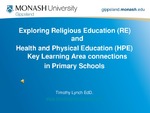Exploring religious education and health and physical education key learning area connections in Primary Schools.
| dc.contributor.author | Lynch, TJ | en |
| dc.date.accessioned | 2015-12-30T09:27:38Z | |
| dc.date.accessioned | 2016-10-09T18:34:42Z | |
| dc.date.available | 2015-12-30T09:27:38Z | |
| dc.date.available | 2016-10-09T18:34:42Z | |
| dc.date.issued | 2012-06-16 | en |
| dc.identifier.uri | http://hdl.handle.net/10026.1/6480 | |
| dc.description.abstract |
The purpose of this study was to explore if connections were made by teachers and students in schools between Religious Education (RE) and Health and Physical Education (HPE) key learning areas (KLA). The research was conducted within three Brisbane (Queensland, Australia) Catholic primary schools of varying enrolment size. It is argued that within Catholic education the HPE curriculum documents are strongly connected to the Religious Education curriculum material (Lynch, 2004). The spiritual dimension of the HPE curriculum is defined in the syllabus as the “sense of connection to phenomena and unusual events beyond self and usual sensory and rational existence; a sense of place within the universe” (Queensland School Curriculum Council, 1999, p.26). The three strands of HPE: personal development; developing the concepts and skills for physical activities; and promoting the health of individuals and communities can all be affiliated closely with the Religious Education curriculum. Furthermore, under the HPE umbrella, physical education sits alongside health education, outdoor education, home economics, and religious education (Macdonald, 2003; Macdonald and Glover, 1997). In primary schools physical learning and physical activities are valuable components of the students’ and school culture. Christian spirituality is the essential link between faith and culture (Gallagher, 1997). Hence, it is logical that the learning area for ‘learning in, through and about movement’, HPE, may offer opportunities for Catholic schools to develop Christian spirituality usually associated with the Religious Education learning area. As Buchanan and Hyde (2008, p. 310) share “religious education is one field of study that can effectively address the complementarity between cognitive, affective and spiritual dimensions of learning”. Qualitative research investigating Religious Education (RE) development through Health and Physical Education (HPE) learning experiences was conducted. Participants included teachers and students from the three respective schools. The research concluded that well implemented quality inclusive physical activities within HPE lessons increased participant’s connections between the two key learning areas. | en |
| dc.format.extent | 1 - 19 | en |
| dc.language.iso | en | en |
| dc.publisher | Common Ground Publishing | en |
| dc.relation.replaces | http://hdl.handle.net/10026.1/4078 | |
| dc.relation.replaces | 10026.1/4078 | |
| dc.title | Exploring religious education and health and physical education key learning area connections in Primary Schools. | en |
| dc.type | Conference Contribution | |
| plymouth.author-url | https://www.youtube.com/watch?v=5RtZhtYe-GQ | en |
| plymouth.date-start | 2012-06-14 | en |
| plymouth.date-finish | 2012-06-16 | en |
| plymouth.date-finish | 2012-06-16 | en |
| plymouth.publisher-url | https://www.youtube.com/watch?v=5RtZhtYe-GQ | en |
| plymouth.conference-name | The Tenth International Conference on New Directions in the Humanities. | en |
| plymouth.publication-status | Published | en |
| plymouth.organisational-group | /Plymouth | |
| plymouth.organisational-group | /Plymouth/Faculty of Arts, Humanities and Business | |
| plymouth.organisational-group | /Plymouth/Faculty of Arts, Humanities and Business/Plymouth Institute of Education | |
| dc.publisher.place | Montréal, Canada. | en |
| dc.publisher.place | Montréal, Canada. | en |
| dcterms.dateAccepted | 2012-05-09 | en |
| dc.rights.embargoperiod | No embargo | en |
| rioxxterms.licenseref.uri | http://www.rioxx.net/licenses/all-rights-reserved | en |
| rioxxterms.licenseref.startdate | 2012-06-16 | en |
| rioxxterms.type | Conference Paper/Proceeding/Abstract | en |
| plymouth.oa-location | https://www.youtube.com/watch?v=5RtZhtYe-GQ | en |


